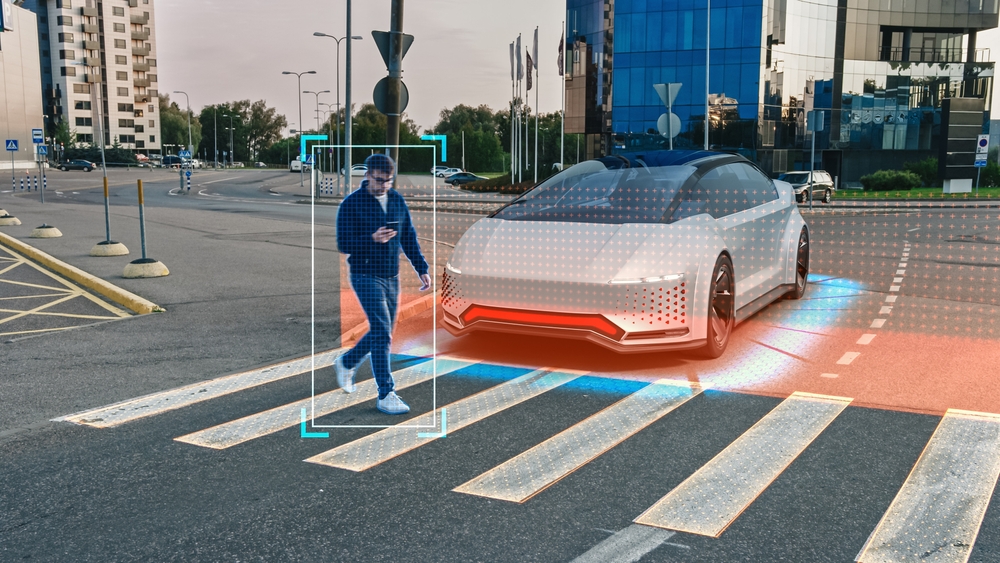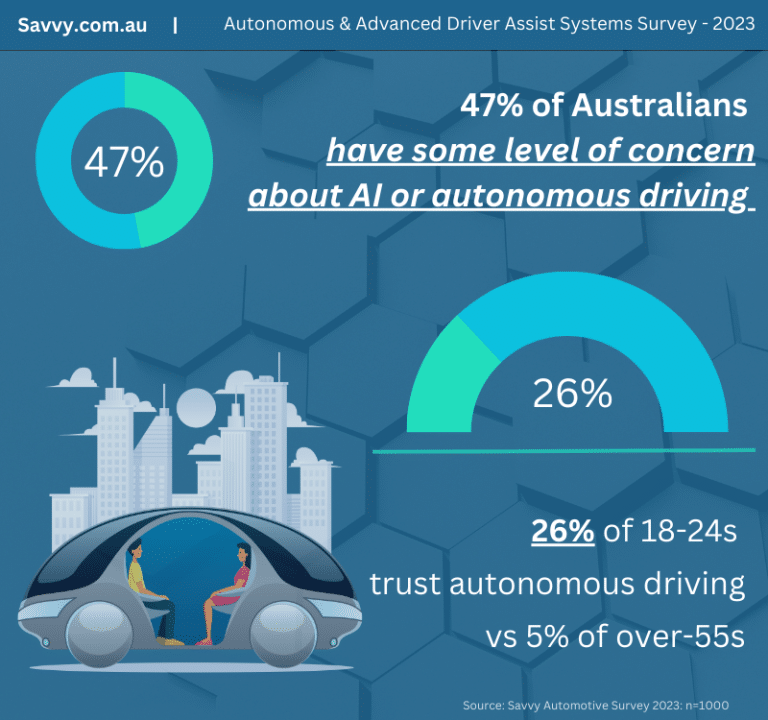
- The Savvy Promise
At Savvy, our mission is to empower you to make informed financial choices. While we maintain stringent editorial standards, this article may include mentions of products offered by our partners. Here’s how we generate income.
In this article
As part of Savvy’s research into Australian consumer sentiments and technology, we look at attitudes towards a new automotive frontier: AI-assisted or autonomous driving features in new car models.
- 47% of Australians have some level of concern about AI or autonomous driving features
- 26% of 18–24-year-olds trust autonomous driving compared with just 5% of over 55s
- 52% of Australians choose 360° cameras and assisted parking as must-have tech in new cars
- 50% say blind spot monitoring, followed by 35% saying a touchscreen display is important
A representative survey of 1,000 Australian adults by Savvy has shown that 52% of respondents say that autonomous parking features such as 360° cameras are their “must have” feature in a new car.
Artificial intelligence (AI) or autonomous driving technology is becoming a mainstay in Australian automotive. This has been encouraged in part by the Australasian New Car Assessment Program including “active safety” technology as part of its new safety rating criteria as of January 2023.
Other active safety measures Australians consider important in a car purchase are blind spot monitoring (50%), emergency braking systems (32%), adaptive cruise control (28%), and lane change assist (18%).
35% of those surveyed said touchscreen displays were important, followed by Apple CarPlay/Android Auto integration (34%), and keyless entry and/or a dedicated smartphone app (31%).
Women were more likely to choose safety features over men, such as 56% of women choosing 360° cameras as important compared with 56% of men. 37% of women versus 27% of men saw emergency braking as important, while 38% of men over 32% of women saw a touchscreen as a “must have” feature.
Safety feature importance seemed to increase as cohorts got older such as 44% of 18-24s saying blind spot monitoring was important over 62% of 55-64s.
General tech such as Apple CarPlay/Android Auto was of most importance to 18-24s (50%) decreasing among all subsequent cohorts, with only 18% of the over 65s stating the same.

Generation gap: young say yes, older drivers cautious
Though we may be a long way from driverless cars, 22% of Australians say they don’t trust and feel uncomfortable with new driving or autonomous tech, with 25% saying they have some doubts and concerns.
Only 9% say they fully trust and feel comfortable with autonomous driving. 23% said they were neutral about the tech.
26% of 18-24s said they fully trust autonomous driving tech; only 8% of 45-54s, 3% of 55-64s, and 2% of over 65s saying the same.
Savvy spokesperson Adrian Edlington says that EV charging stations and solar power may be as desirable as outdoor entertaining areas or pool decks when looking for places to live:
“In an earlier report, men aged forty to sixty-four are the highest risk of being a road fatality in Australia, and autonomous driving technology could possibly bring this awful statistic down,” he says.
“As more of these technologies are refined and included in new cars and electric vehicles, it’s inevitable Australian drivers will embrace them as potentially life-saving and useful technologies. Manufacturers who neglect these new technologies as a cost-saving measure will likely get left behind.”
Which advanced technology features do you consider important in a car purchase?
| Total | 1000 | Male (499) | Female (495) | Other (6) | Keyless entry / dedicated smartphone app | 31% | 34% | 27% | 50% |
|---|---|---|---|---|
| Apple CarPlay / android integration | 34% | 33% | 35% | - |
| Touchscreen display | 35% | 38% | 32% | 50% |
| Adaptive cruise control | 28% | 33% | 23% | 17% |
| Electronic door handles | 7% | 7% | 6% | - |
| Hands-Free Power Tailgate / Boot | 11% | 9% | 13% | 17% |
| Lane assist | 18% | 21% | 16% | 33% |
| Blind spot monitoring (& other driving safety features) | 50% | 46% | 53% | 67% |
| 360 view cameras (& other parking / reversing features) | 52% | 48% | 56% | 50% |
| Emergency braking | 32% | 27% | 37% | 17% |
| Other | 3% | 4% | 2% | - |
*respondents choose top three features
To what extent do you trust or feel comfortable with the idea of autonomous driving capabilities in vehicles?
| Total | 1000 | Male (499) | Female (495) | Other (6) | I fully trust and feel comfortable with autonomous driving capabilities | 9% | 10% | 8% | 17% |
|---|---|---|---|---|
| I trust and feel mostly comfortable, but with some reservations | 20% | 23% | 18% | 17% |
| I am neutral or unsure about autonomous driving capabilities | 23% | 25% | 22% | 17% |
| I have some doubts and concerns, but may consider it | 25% | 20% | 30% | 33% |
| I do not trust and feel uncomfortable with autonomous driving capabilities | 22% | 22% | 23% | 17% |
Do we have driverless cars in Australia?
As of September 2023, there are no driverless cars on the roads in Australia. Driverless cars are vehicles that require no user intervention to control. They theoretically work using a mixture of GPS technology, detection sensors such as LADAR (light or laser scanning) and cameras that “sense” obstacles and other moving objects using artificial intelligence through a powerful onboard computer. This computer is responsible for “driving” the car and whether it should take certain actions based on the data it receives from the car and outside world. This technology is new and still needs refinement. It’s unclear when this sort of technology will be available in Australia.
The combination of GPS, detection sensors, and computer control forms the basis for assisted or autonomous driving technology.
What is adaptive cruise control?
Adaptive cruise control is a type of driver assistance or autonomous driver technology that adjusts your car’s speed to match the car in front, reducing the risk of collisions. High-end cars feature this technology and they cost $2,000 extra if not offered as a standard feature.
What is autonomous emergency braking?
Autonomous emergency braking is an emergency braking system that kicks in if a driver is at risk of imminent collision into an object in front of the car. Using cameras and AI, the computer will override driver input to stop the car as quickly as possible.
What is lane keep assist?
This technology warns drivers if you start to drift out of your lane and theoretically prevent crashes due to poor driver attention or fatigue. Some automatic lane keeping systems will steer the car back into the lane. Many different models and car marques have lane keep assist built in, with varying degrees of accuracy. Some newer models may even work without clear lane markers. This may cost $1,500 to include in a car, though automated steering models will cost more.
What is active parking assist?
Using a combination of 360° cameras, LADAR, and artificial intelligence, active parking assist will hand over control of your car to a computer to complete parking procedures by itself. The driver will not need to steer the car at all. Many new models may have this included, but the more common addition is passive parking assist, which helps drivers with parking using cameras, artificial overlays, and proximity alarms to prevent crashes or scrapes. This costs about $1,000 extra to include in new cars.
What is blind spot monitoring?
Blind spot monitoring is a sensor, usually using cameras or LADAR or a combination thereof, that helps detect other vehicles and obstacles to the driver’s side and rear, usually unseen under normal driving circumstances (hence “blind spot.”) They can warn the driver about potential collisions through visual cues, alarms, or vibrations. Some blind spot monitors may be used in conjunction with other autonomous systems to avoid crashes, such as rear-cross traffic alert, which alerts drivers backing out of parking spaces when traffic is approaching from the sides. Autonomous brakes may take over in this situation.
Savvy 2024 Car Buying Sentiments Survey; n=1000
Nationally representative survey of 1000 adult Australians, aged 18 and over. Conducted by Octopus Group, on behalf of Savvy.
Completion date: 2/09/2023
Age groups:18-24, 25-34, 35-44, 45-54, 55-64, 65+
Gender breakdown: male n=499, female n=495, non-binary /prefer not to say n=6
Representative of state and territory populations:
NSW n=320 (32.3%), Vic n=252 (25.1%), Qld n=194 (20.2%), SA n=75 (7.2%), WA n=108 (10.6%) NT n=9 (0.7%), Tas n=23 (2.2%), ACT n=19 (1.7%)
Did you find this page helpful?
Author
Adrian EdlingtonPublished on September 8th, 2023
Last updated on March 14th, 2024
Fact checked
This guide provides general information and does not consider your individual needs, finances or objectives. We do not make any recommendation or suggestion about which product is best for you based on your specific situation and we do not compare all companies in the market, or all products offered by all companies. It’s always important to consider whether professional financial, legal or taxation advice is appropriate for you before choosing or purchasing a financial product.
The content on our website is produced by experts in the field of finance and reviewed as part of our editorial guidelines. We endeavour to keep all information across our site updated with accurate information.










